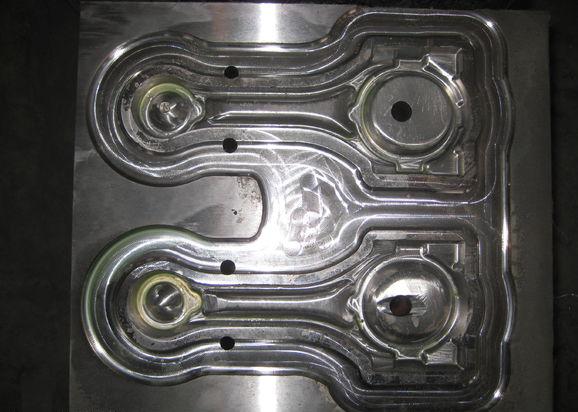Closed Die Forging Dies

Closed die forging dies,normally consist of forging dies,trimming dies and sometimes flat dies. Like dies for the punch-press,are of several different types. Perhaps the most simple form of closed die forging die would be a pair of dies for producing a simple round forging, as, for instance, a gear blank.These dies would require a central impression turned in each of the dies of the pair. Before using the dies, a square plate of steel is worked under the hammer, drawing out a short shank at the side, and "knocking down" the corners. This roughly shaped block of steel is held by the shank and placed between the dies and thus brought to shape.
The most common form of closed die forging die, however, is the one in which there is a central impression to shape the forging, and a side impression, called the "edger," "break-down" or "side-cut,"that helps to properly distribute the hot steel(refer to select die material of closed die forging). To make clear the use of these two sets of impressions,a closed die forging die of this description may be likened to a drawing of the finished forging,in which the outline of the central impression would resemble the plan view of the forging, and the two halves of the edger would correspond to the side elevation of the forging. Of course this illustration is not literally correct, but it expresses the general idea. The edger is always on the right-hand side of the die, and the steel bar is struck first in the break-down, edgewise, and then turned and struck flat in the impression, alternating in this manner until the forging is "full."
There are also dies that in addition to the central impression and the edger are made with an anvil or "fuller." as it is sometimes termed. The anvil is formed in the dies at the left-hand side, and is used to draw out the stock previous to striking it in the edger or in the impression Itself. Dies with anvils are necessary in making closed die forgings in which there is a considerable displacement of the stock. A double-ended wrench,which is thin in some places and very much thicker and wider in other places,may be mentioned as an example.The anvil consists of two flat-faced parts of the die,whose faces,called "fullers,"come just near enough together to flatten the stock to such dimensions that when finished in the central impression very little stock will be left to be squeezed out as the fin. After the stock has been thus drawn out to roughly fit the impression, the closed die forging is shaped in the usual way by means of the edger and the die impressions. A considerable number of large closed die forging dies require anvils.In making the dies for difficult forgings,there are often other special features incorporated in the dies,which will be more fully described later.
Thus far we have considered only dies with one impression, but in dies for first-class quality and wide application of closed die forging, especially when there is a large number to be made,two impressions are provided,the forming and the finishing.The forging is nearly completed by the edger and the forming impression (and anvil if needed), and finally struck several blows in the finishing impression to bring it up to size and finish it. Thus the finishing impression is saved the severe duty of completely forming the closed die forging, and hence the dies last longer.On small and medium-sized forgings these two impressions are placed side by side in the same die, but if the forging is large,the finishing impression is made in a separate set of die-blocks and set up in a hammer set close to that which forms the forging. The forger uses both hammers to get out the work in such cases. It is seldom that more than two impressions are cut in the same set of dies, but if the piece is small and the number of pieces to be forged great, it is often advisable to make the sets of dies with two or more finishing impressions in addition to the forming impression. If this is done, the die has a longer life, for after one of the finishing impressions gives out by spreading or "checking," there is still a good finishing impression left. In addition to these different styles of closed die forging dies, the dies for trimming the fin from the forging must be taken into consideration. As already indicated, trimming dies are of two classes:those for trimming the forging while it is hot. and those for trimming the forging after it is cold. The making of closed die forging dies for forgings of other metals than steel involves the use of special methods.


 sales@dropforging.net
sales@dropforging.net